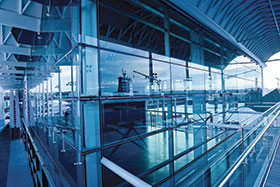

There are many manufacturing industries where temperature is involved in the process and proper control of these temperatures is essential to ensure product quality. The glass industry is no exception.
Flat glass
Temperature monitoring is critical in each stage of flat glass production. Incorrect temperatures or rapid temperature changes cause uneven expansion and contraction, resulting in improper annealing.
At the tin bath (float oven), sensors are mounted over each zone to ensure correct glass temperature. After the flat glass exits the float zone oven, it has to be cooled in the annealing lehr. During this process, the temperature profile across the glass is quite critical. If the glass is cooled properly during its time in the lehr, it will have a good property called cutability which means it will be easier to cut into the final shape and there will be less breakage of the glass. The obvious goal is to get the most finished glass that is possible from the process. The annealing lehr therefore has several temperature control zones. Each zone needs control of the glass surface temperature and edge-to-edge temperature.
Bottles and containers
From the furnace, the molten glass flows into one or more forehearths (depending on the size of the operation), where it is kept at a uniform temperature. At the end of the forehearth, the gob is dropped into moulds where initial forming is done by either a blowing process (compressed air) or pressing process using plungers and moulds.
Maintaining the proper temperature in the forehearth is critical to ensure that the molten glass is in the proper homogenous condition when it reaches the exit. When the gob is forced out of the opening, it must have the proper viscosity (a 1°C change causes a 1% change in viscosity).
Glass fibre
There are two main processes for making glass fibre: crown wool and white wool. In both these processes, temperature control is crucial to ensure product quality. The forehearth zone temperatures has to be carefully controlled to allow the engineer to maintain the optimum molten glass temperatures (viscosity) as it enters the fibreiser (spinner). Control of temperature at the spinner is essential to maintain consistency of the fibre glass strands and to prevent the spinner holes from clogging. Clogged holes can cause glass ‘slugs’ to enter the glass mat. Hot glass slugs can ignite the backing paper of insulation many days after production is complete. At the curing oven, proper temperature control must be maintained or the binding agent will not cure properly. If paper and/or foil is glued to the glass fibre after curing, the fibre must be at the correct temperature for the material to properly adhere.
Infrared temperature monitoring
In many applications, temperature readings show whether processes are operating within their proper ranges. By utilising non-contact infrared thermometers, each stage can be accurately monitored so the glass retains the correct properties as it travels through the process.
Every section of the glass manufacturing process can benefit from the use of infrared thermometers. These benefits include higher quality products, increased productivity, reduced energy costs, enhanced worker safety, reduced downtime and easy data recording.
R&C; Instrumentation covers the full range of infrared temperature measuring devices form Raytek and Ircon, both well-known industry standards. The scanners from both companies come as complete applications packages with tried and tested software to fit perfectly into many industrial applications, including the glass industry.
Continual innovation and new products like the Endurance and Thermalert series, designed in conjunction between Raytek and Ircon, now combined as Fluke Process Instruments, ensure that whatever the temperature measurement and monitoring requirements, a solution can be found.
| Tel: | +27 11 608 1551 |
| Email: | [email protected] |
| www: | www.randci.co.za |
| Articles: | More information and articles about R&C Instrumentation |

© Technews Publishing (Pty) Ltd | All Rights Reserved